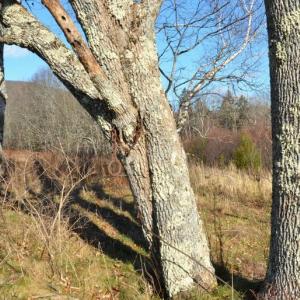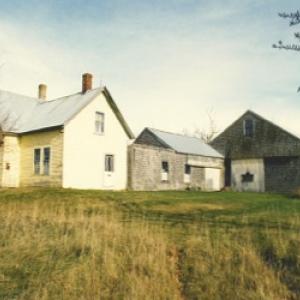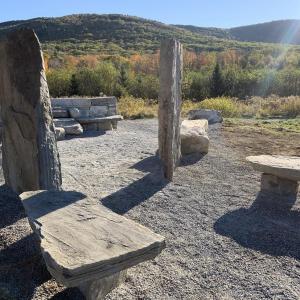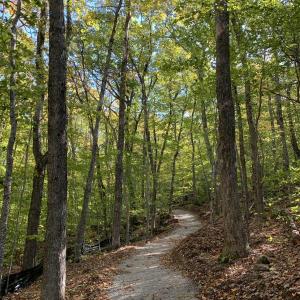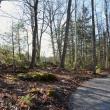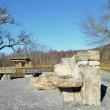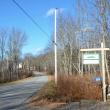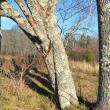Coastal Mountains Land Trust opens western entrance to popular Round the Mountain Trail
 Coastal Mountains Land Trust Executive Director Ian Stewart, standing in the stone seating area built by Stonescape Masonry, at the Thorndike Brook Trailhead, on Hope Street. (Photo by Lynda Clancy)
Coastal Mountains Land Trust Executive Director Ian Stewart, standing in the stone seating area built by Stonescape Masonry, at the Thorndike Brook Trailhead, on Hope Street. (Photo by Lynda Clancy)
 Along the trailhead, cedar bridges constructed by Off the Beaten Path Trailworks ford small streams. (Photo by Lynda Clancy)
Along the trailhead, cedar bridges constructed by Off the Beaten Path Trailworks ford small streams. (Photo by Lynda Clancy)
 A a sheltering kiosk designed by architect Gianne Conard and built by Wayne Ruesswick and Cedarworks at the Thorndike Brook Trailhead on Hope Street.
A a sheltering kiosk designed by architect Gianne Conard and built by Wayne Ruesswick and Cedarworks at the Thorndike Brook Trailhead on Hope Street.
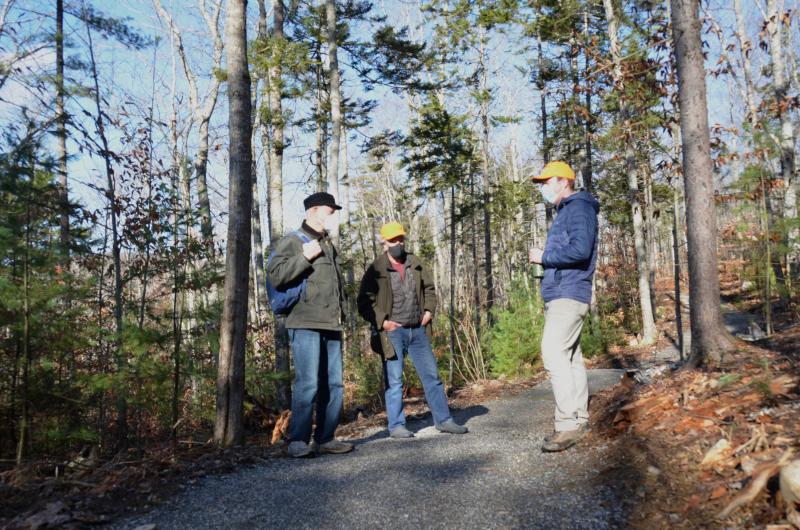 Hikers John Scholz and Tony Oppersdorff chat with Ian Stewart on the spur to the Round the Mountain Trail.
Hikers John Scholz and Tony Oppersdorff chat with Ian Stewart on the spur to the Round the Mountain Trail.
 The Thorndike Brook Trailhead weaves alongside old farm stone walls. (Photo by Lynda Clancy)
The Thorndike Brook Trailhead weaves alongside old farm stone walls. (Photo by Lynda Clancy)
 The old Myrven Merrill farmhouse, on the Rockport land now designated as the Thorndike Brook Trailhead. (Photo courtesy Coastal Mountains Land Trust)
The old Myrven Merrill farmhouse, on the Rockport land now designated as the Thorndike Brook Trailhead. (Photo courtesy Coastal Mountains Land Trust)
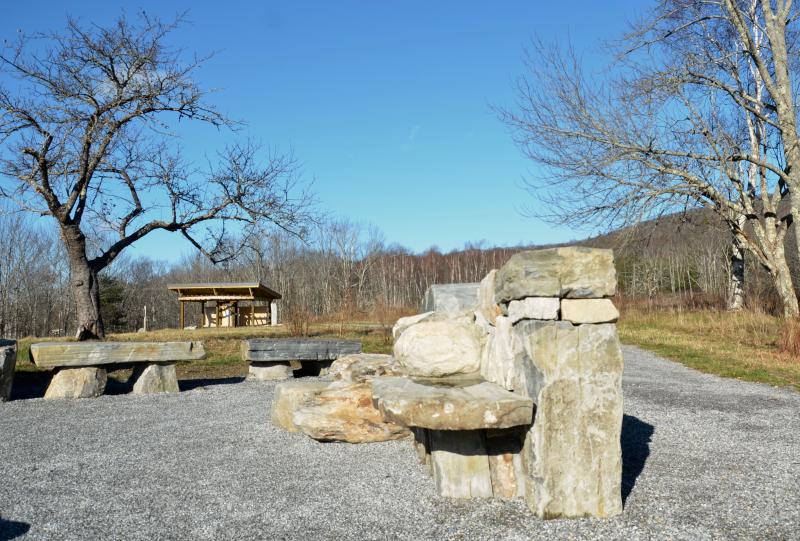




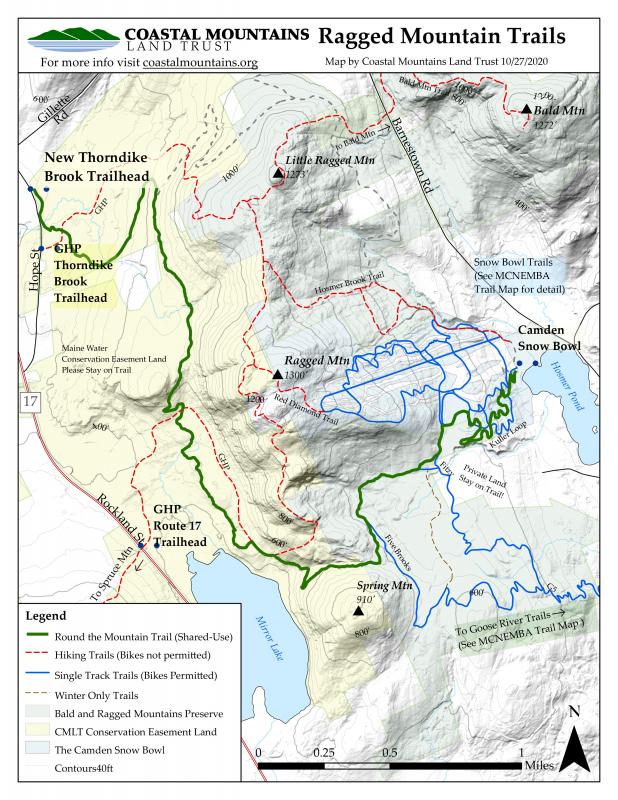
 The old Myrven Merrill farmhouse, on the Rockport land now designated as the Thorndike Brook Trailhead. (Photo courtesy Coastal Mountains Land Trust)
The old Myrven Merrill farmhouse, on the Rockport land now designated as the Thorndike Brook Trailhead. (Photo courtesy Coastal Mountains Land Trust)

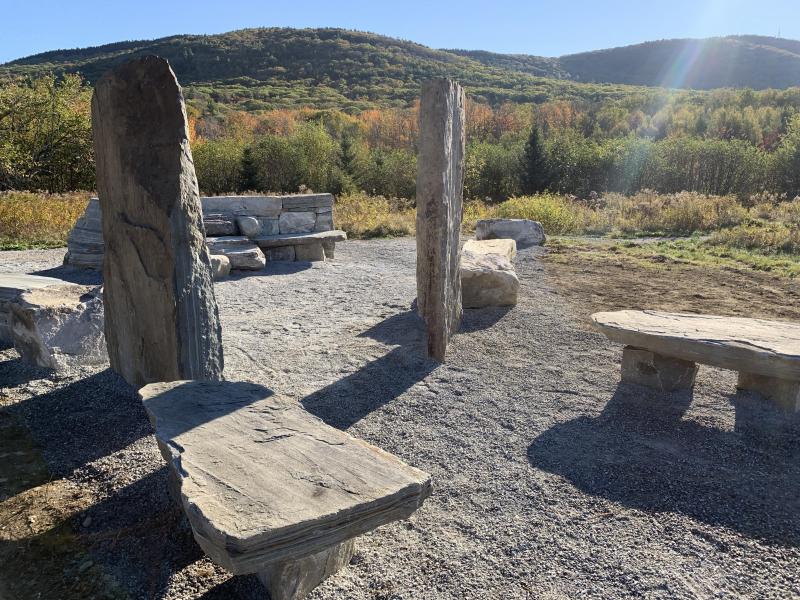 Photo courtesy Coastal Mountains Land Trust)
Photo courtesy Coastal Mountains Land Trust)
 Photo courtesy Coastal Mountains Land Trust)
Photo courtesy Coastal Mountains Land Trust)
 Coastal Mountains Land Trust Executive Director Ian Stewart, standing in the stone seating area built by Stonescape Masonry, at the Thorndike Brook Trailhead, on Hope Street. (Photo by Lynda Clancy)
Coastal Mountains Land Trust Executive Director Ian Stewart, standing in the stone seating area built by Stonescape Masonry, at the Thorndike Brook Trailhead, on Hope Street. (Photo by Lynda Clancy)
 Along the trailhead, cedar bridges constructed by Off the Beaten Path Trailworks ford small streams. (Photo by Lynda Clancy)
Along the trailhead, cedar bridges constructed by Off the Beaten Path Trailworks ford small streams. (Photo by Lynda Clancy)
 A a sheltering kiosk designed by architect Gianne Conard and built by Wayne Ruesswick and Cedarworks at the Thorndike Brook Trailhead on Hope Street.
A a sheltering kiosk designed by architect Gianne Conard and built by Wayne Ruesswick and Cedarworks at the Thorndike Brook Trailhead on Hope Street.
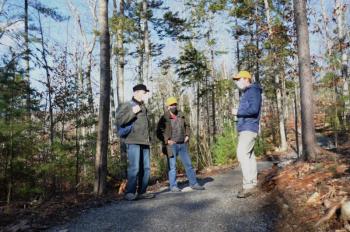 Hikers John Scholz and Tony Oppersdorff chat with Ian Stewart on the spur to the Round the Mountain Trail.
Hikers John Scholz and Tony Oppersdorff chat with Ian Stewart on the spur to the Round the Mountain Trail.
 The Thorndike Brook Trailhead weaves alongside old farm stone walls. (Photo by Lynda Clancy)
The Thorndike Brook Trailhead weaves alongside old farm stone walls. (Photo by Lynda Clancy)
 The old Myrven Merrill farmhouse, on the Rockport land now designated as the Thorndike Brook Trailhead. (Photo courtesy Coastal Mountains Land Trust)
The old Myrven Merrill farmhouse, on the Rockport land now designated as the Thorndike Brook Trailhead. (Photo courtesy Coastal Mountains Land Trust)
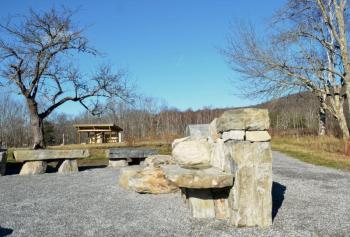





 The old Myrven Merrill farmhouse, on the Rockport land now designated as the Thorndike Brook Trailhead. (Photo courtesy Coastal Mountains Land Trust)
The old Myrven Merrill farmhouse, on the Rockport land now designated as the Thorndike Brook Trailhead. (Photo courtesy Coastal Mountains Land Trust)

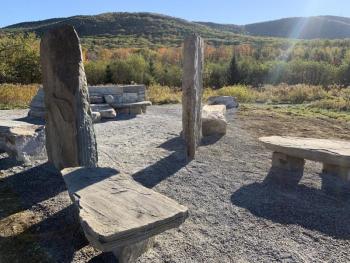 Photo courtesy Coastal Mountains Land Trust)
Photo courtesy Coastal Mountains Land Trust)
 Photo courtesy Coastal Mountains Land Trust)
Photo courtesy Coastal Mountains Land Trust)
RAGGED MOUNTAIN — Public access to the extensive Round the Mountain Trail took a giant step forward this week with the opening of the Thorndike Brook Trailhead, at 223 Hope Street, in Hope, just overlapping the Rockport town line. And with it came the official Coastal Mountains Land Trust announcement that the first 5.5 miles of the Round the Mountain Trail is now open for hiking, running and biking.
And as far as trailheads go, the Thorndike Brook Trailhead is a small park unto itself, with a sheltering kiosk designed by architect Gianne Conard and built by Wayne Ruesswick and Cedarworks, with lumber donated by Hammond Lumber.
A few steps away, an artfully constructed stone garden graces the landscape, courtesy of Kurt Snyder and his company, Stonescape Masonry.
It’s a place to park, meet friends, and explore Ragged Mountain territory opened up by the newly built Round the Mountain Trail, and the older Georges Highland Path, a narrower trail that goes up over the summit of Ragged Mountain. The trailhead path is a gentle quarter-mile incline, the first part of which is ADA complaint, wide and smooth, and covered with packed gravel.
“I’m excited,” said CMLT Director Ian Stewart. “It’s really, really good. We have a much more finished and nicer looking project that I ever imagined.”
And, that was a day after the region received a four-inch rainfall. Still, it was visibly apparent that the trail held up just fine despite run-off that coursed down the mountain during the strong storm.
The Thorndike Brook Trailhead begins at once was an old farm owned by Myrven Merrill, a Union machinist and blacksmith. Pieces of his farm you will still see — old fruit trees and farm equipment intertwined into the landscape. The farm, and 786 acres around it are under the ownership of Maine Water, the privately-owned water company that provides water to five Midcoast communities.
Four years ago, the water company sold permanent easements, including the farmland, to Coastal Mountains to ensure its Round the Mountain land conservation and trail project.
And the trailhead opening marks a significant milestone in the nine-mile Round the Mountain Trail. It will serve as one of two strategically located spurs (the other will be created off of the Gillette Road) that weave into the long Round the Mountain trail.
Stewart is hiking up the Thorndike Brook Trail, toward the intersection with the main trail. The path is wide, with plenty of room for bikes to pass each other going in opposite directions, or for hikers to walk abreast with each other, instead of single-file.
At the lower slopes of Ragged Mountain’s west and northwest side, the woods are thick, and brooks carve down between the trees. The land at one point had been clear-cut, and old stone walls edge part of the trail landscape. Newly built cedar bridges span the brooks and wetter forested areas.
The $1.5 million Round the Mountain Trail is the crown jewel of a decade-long $5.5 million project to permanently conserve open space and wildlife habitat on and around Ragged Mountain, and protect the drinking water that Maine Water controls.
But the trail also represents a newer approach to land conservation, which encourages people to enjoy, explore and understand better the terrain that is being preserved in its natural state.
So far, the first 5.5 miles of the trail are open, and hikers, runners and bicyclists can now start at either end, the Camden Snow Bowl or the Thorndike Brook Trailhead. The rest of it, another four miles, will extend beyond the Thorndike Brook Trailhead intersection, curve around the north side of Ragged Mountain and back to the Snow Bowl.
Off the Beaten Path Trailworks, a Brunswick-based company lead by Jed Talbot, has been working on the Round the Mountain trail for a year, engineering, clearing, leveling, topping it all with gravel, and then rolling and packing it down.
Stewart has been at the helm of the project for seven-plus years. That’s when the idea for a Round the Mountain trail germinated with the land trust, whose headquarters are in Camden, but which has been working for decades to conserve the natural landscape throughout the Midcoast.
It was Scott Dickerson, of Lincolnville, and former director of CMLT: “who hatched the idea, as a way of trying to gain more interest in the project. It was also, for our organization, a way of us embracing a newer model of conservation that involves people more, rather than just, ‘let’s protect land.’”
Stewart qualified, “Not that we locked it away before.” And it is true, CMLT opens its blueberry fields to the public for picking, as well as large tracts of conservation properties for hiking, hunting and cross-country skiing.
But the Round-the-Mountain Trail is meant to bring even more people — the older walkers, the toddlers, those not able to ascend mountain trails with ease, but who want to be outdoors — to explore the woods and slopes of Ragged Mountain, which rises 1,000 feet over the three towns of Camden, Hope and Rockport.
“We had identified that Bald and Ragged mountains being truly unique as a statewide conservation priority in our area,” said Stewart. “We started to reach out and talk to landowners, and we both discovered a lot of trails that were already here, mountain biking trails, and certain amount of activities from the Snow Bowl, and as we got going, it was clear that a lot of people hadn’t physically been up on the mountain, hand’t been to them, couldn’t really imagine going up.”
Dickerson began to flesh out the idea.
“And I joked, ‘is this really possible?’” said Stewart. “He and I walked it early on to see, probably seven years ago. Then I brought out contractors from around the state; someone who ran Baxter State Park, someone who set up the Northern Forest Ski Center, and just asked the question: ‘Are we crazy, considering the steepest areas on the mountain, are we crazy to be thinking this is possible?’ And their reaction was, ‘no, this perfect. It’s great.’”
From idea to reality
Over the course of seven years, the 3,000 acres of land began to fall under conservation, with donations and easements, and outright purchases, with the help of Maine Water, Maine Coast Heritage Trust, and the state-run Land for Maine’s Future.
Off the Beaten Path got to work after CMLT secured a good portion of the trail land, and while the original engineering called for patches of gravel interspersed with stretches of packed dirt, it became apparent that packed gravel was the ideal material.
And it is fine gravel, with bits of mica, that glint in the sun. Three different quarries were involved in producing the gravel — local quarries in the Midcoast, with stone that was ground in Warren.
“We learned a lot about trying to find the right mix,” said Stewart. “That’s fine enough, but you want it to bind and hold.”
Stewart is pleased with the work done by Off the Beaten Path, which has completed a lot of trail work around the state and world.
“We wanted a trail builder who was going to be subtle to knowing design and run-off and drainage and all of those issues,” said Stewart. “We had a lot of people looking at it as a road project.”
The steepest areas are between Spring Mountain and Ragged Mountain.
“But the truth of those is that they are easy to drain and they’re dry,” he said. “It’s the lower areas where there’s a little more run-off.”
And since the soft opening over the past few weeks, there has been, said Stewart, “a ton of new faces — strollers, bikes, young families, and there is a lot of buzz about it.”
On the early December day, two other hikers are enjoying the new trail: John Scholz and Tony Oppersdorff, locals who have been around for many years and know the terrain.
“It’s world class,” said Oppersdorff, about the trail work. “It’s easily accessible to places no one would walk before.”
Scholz agreed.
“It will give a lot of people much pleasure over the coming years.”
And how does the land trust anticipate and head off overuse of a natural resource that is growing in popularity?
Stewart said that Ragged Mountain is home to important wildlife, including bear, nesting owls, bats, fishers, and that deer yards are scattered in protective areas.
The strategy is to designate the trails, and be thoughtful about leaving more of the mountain alone.
“With 3,000 acres of conserved land we want to make sure we are not building trails everywhere,” he said. “It is why we wanted to do one main accessible trail and have a couple of back country options, but not over-trail it.”
And by having two parking lots and other small entrances, people will be spread out, he said.
The capacity is large, he said, and “we are going to monitor and manage it.”
Reach Editorial Director Lynda Clancy at lyndaclancy@penbaypilot.com; 207-706-6657
Event Date
Address
United States










